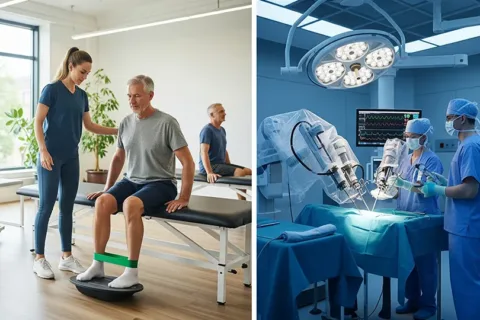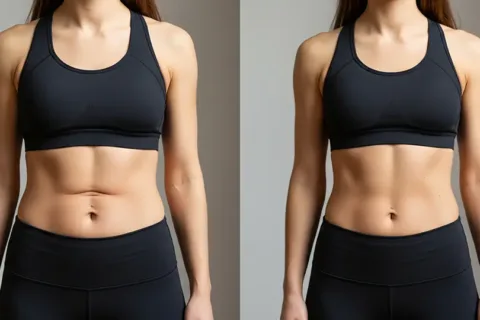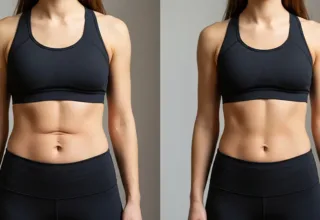Table of Contents
Cupping therapy for chronic back pain has gained popularity in recent years, especially among patients seeking natural and drug-free alternatives. But does it actually work? Can suction cups on your skin reduce deep muscular tension and provide lasting relief?
In this comprehensive guide, we’ll explore how cupping therapy works, what science says, its benefits, potential side effects, and whether it’s right for your chronic back pain management plan.
What is Cupping Therapy?
Cupping therapy is a time-tested healing practice that dates back thousands of years and has been used in various ancient cultures, including Traditional Chinese Medicine (TCM), Unani medicine, and Islamic healing traditions (where it’s known as Hijama).

At its core, cupping therapy involves the placement of specialized cups on specific areas of the skin to create a localized suction effect. This suction is believed to draw stagnant blood, toxins, and energy blockages to the surface of the body, where they can be more effectively cleared through natural processes.
How does Cupping work?
The therapy works on the principle of negative pressure. When a vacuum is created inside the cup, it pulls the skin slightly upward, lifting muscle and fascia layers. This:
- Stimulates blood flow and increases circulation to the affected area
- Encourages lymphatic drainage, helping clear metabolic waste
- Relieves muscle tension and reduces spasms
- Promotes cellular repair by triggering an inflammatory healing response
- Activates the parasympathetic nervous system, promoting relaxation
Cupping may leave circular red or purple marks, which are not bruises but signs of stagnation being released.
How does Cupping help with Chronic Back Pain?
Chronic back pain affects millions of people globally and can significantly reduce one’s quality of life. While its causes can vary, they often include:

Common Causes of Chronic Back Pain
Scar tissue and trigger points: Old injuries can result in adhesions or hyperirritable spots in the fascia and muscles that refer pain throughout the back.
Muscle tightness or imbalance: Sitting for long periods, overuse, or lack of physical activity leads to stiff muscles, particularly in the lower back.
Poor posture: Slouching, improper ergonomics, and weak core muscles place excess strain on the spine and its supporting structures.
Stress and tension: Emotional stress often manifests physically as muscle knots, especially in the back, shoulders, and neck.
Inflammation: Ongoing inflammation in the back tissues or spine can cause pain and stiffness.
How Cupping Provides Relief
Cupping therapy targets these underlying issues through its unique mechanisms:
1. 🔄 Enhancing Blood Circulation

The negative pressure from the suction draws blood to the surface, bringing fresh oxygen and nutrients to muscles and soft tissues. This helps:
- Accelerate healing
- Remove metabolic waste
- Decrease stiffness
- Improve tissue pliability
2. 🧵 Releasing Fascial Restrictions

Fascia is the thin connective tissue that surrounds muscles and organs. When it becomes tight or stuck due to injury or poor movement, it restricts mobility and causes pain. Cupping helps stretch and mobilize fascial layers, restoring normal movement and reducing pain.
3. 🧘♂️ Activating the Parasympathetic Nervous System

The act of cupping can induce a deep relaxation response by stimulating the parasympathetic nervous system. This helps:
- Reduce cortisol levels (stress hormone)
- Relax muscle tone
- Improve sleep quality
- Ease mental and physical tension that often worsens chronic pain
4. 🔥 Reducing Inflammation

Research suggests that cupping downregulates pro-inflammatory cytokines and reduces oxidative stress in soft tissues. This can lead to less swelling, better joint function, and long-term pain relief—especially in cases of chronic inflammation, such as sciatica or fibromyalgia.
5. 🔓 Decompressing Soft Tissue

Unlike massage, which compresses the tissue, cupping lifts and separates layers of muscles, fascia, and skin. This decompression technique:
- Loosens tight muscle bands
- Improves lymphatic flow
- Breaks down adhesions or scar tissue
- Restores normal range of motion
6. 🎯 Targeting Myofascial Trigger Points

Trigger points—also known as “knots”—can refer pain to distant parts of the body (e.g., a knot in the glute can radiate pain down the leg). Cupping gently stretches and oxygenates these areas, reducing trigger point sensitivity over time.
Combining Cupping With Physiotherapy for Long-Term Results

For best outcomes, many physiotherapists use cupping as part of a holistic treatment plan that includes:
- Stretching & strengthening exercises: Especially for core, glutes, and back extensors
- Manual therapy: Mobilization of the spine and soft tissues to correct alignment and improve posture
- Postural correction training: Teaching ergonomic awareness to prevent recurrence
- Modalities like dry needling, heat therapy, or TENS for multimodal relief
When integrated this way, cupping isn’t just a temporary fix—it becomes a catalyst for long-term healing and resilience.
What does Science say about Cupping therapy for Chronic Back Pain?

Cupping therapy has been practiced for thousands of years in Traditional Chinese Medicine (TCM), Unani, and Islamic traditions. However, in the modern medical and physiotherapy world, it’s essential to evaluate these practices through the lens of scientific research. So, what does current science actually say about cupping for chronic back pain?
✅ Positive Scientific Findings
Over the past two decades, several randomized controlled trials and systematic reviews have investigated the effects of cupping therapy on musculoskeletal pain, especially chronic low back pain (CLBP). Here are some key findings:
📚 1. Meta-Analysis: Moderate Evidence of Pain Relief
A 2018 meta-analysis published in the Journal of Traditional and Complementary Medicine reviewed 16 studies and found moderate evidence that cupping therapy is more effective than no treatment or conventional care alone for reducing chronic back pain and disability. Many participants reported:
- Decreased pain intensity
- Improved functional movement
- Enhanced quality of life
📊 2. Randomized Controlled Trials Show Positive Effects
A 2020 clinical trial published in BMC Complementary Medicine and Therapies focused on dry cupping and its effects on chronic low back pain. Patients who received dry cupping reported:
- Significant improvement in pain scores using the Visual Analog Scale (VAS)
- Increased lumbar flexibility
- Reduced use of pain medications after consistent cupping sessions
🧪 3. Reduction in Inflammatory Markers
Some studies have measured biomarkers (e.g., CRP and TNF-alpha) and found that cupping can reduce levels of inflammation in the blood. Since chronic back pain is often associated with low-grade inflammation, this mechanism is scientifically plausible.
🧠 4. Neurophysiological Benefits
Cupping stimulates skin and muscle receptors, which may influence pain perception by activating the gate control theory of pain — essentially “closing the gate” to pain signals traveling to the brain. This theory has been foundational in pain neuroscience.
⚠️ Limitations of Existing Research
While early research is promising, there are still notable gaps and limitations that should be acknowledged:
🔍 1. Small Sample Sizes
Many studies have limited participants (typically 30–100), which can reduce the reliability and generalizability of their results. Larger, multicenter trials are needed.
❌ 2. Lack of Placebo-Controlled Designs
It’s difficult to create a “placebo” for cupping. Even sham cupping (without suction) might produce some physiological effects. This makes it hard to isolate cupping’s true effectiveness compared to the placebo effect.
📅 3. Short-Term Follow-Up
Most studies follow patients for just a few weeks. There’s a lack of long-term data showing whether pain relief lasts for months or years.
🔄 4. Variability in Technique
There are different types of cupping — dry, wet, fire, moving — and variations in duration, suction intensity, and cup materials. This lack of standardization makes comparisons between studies challenging.
🧠 Scientific Consensus: Cupping as Complementary, Not Standalone
While cupping may not be a standalone cure, it is increasingly recognized as a complementary modality within a broader rehabilitation or physiotherapy plan. According to the National Institutes of Health (NIH) and World Health Organization (WHO), cupping is considered safe when practiced by trained professionals and may offer measurable benefits, particularly for:
- Chronic low back pain
- Neck and shoulder stiffness
- Myofascial pain syndrome
💬 What do Physiotherapists say about Cupping Therapy for Chronic Back Pain?

Cupping therapy for chronic back pain is no longer confined to traditional or alternative medicine clinics — it has found its way into modern physiotherapy settings around the world. Increasingly, licensed physiotherapists view cupping not just as a historic technique, but as a complementary clinical tool that, when used strategically, can support the treatment of chronic musculoskeletal conditions, particularly back pain.
🎓 Cupping as a Soft Tissue Mobilization Tool
In the physiotherapy community, cupping is often categorized under instrument-assisted soft tissue mobilization (IASTM). Instead of using hands or metal tools, suction cups apply negative pressure on the skin and fascia to:
- Release myofascial adhesions
- Increase blood circulation to the target area
- Stimulate lymphatic drainage
- Promote tissue relaxation and healing
🗣️ “Cupping is great for reducing myofascial tension and restoring mobility. I often pair it with corrective exercises and posture retraining.”
— Dr. Iqra Kiran, Consultant Physiotherapist
Physiotherapists use cupping both before and after exercise-based therapy to prime the muscles or enhance recovery, depending on the patient’s condition and therapy goals.
🏥 Clinical Use Cases Among Physiotherapists
Physiotherapists may recommend cupping therapy in cases such as:
- Chronic low back pain due to muscle tightness or poor posture
- Sciatica with myofascial trigger points
- Postural strain from prolonged desk work or lifting
- Muscle recovery for athletes after intense training
- Soft tissue injuries where deep friction massage is contraindicated
“Cupping can be an excellent alternative to deep tissue massage, especially for patients who can’t tolerate manual pressure. It provides decompression instead of compression — which can feel less invasive.”
— Dr. Iqra Kiran, Consultant Physiotherapist
🌀 Different types of Cupping Therapy for Chronic Back Pain
Cupping isn’t a one-size-fits-all therapy. Instead, it encompasses a variety of techniques, each tailored to the patient’s condition, the desired therapeutic effect, and the practitioner’s expertise. Below are the most common types of cupping therapy, along with their clinical applications — especially in the management of chronic back pain.
1. Dry Cupping (Static Cupping)

What it is:
This is the most traditional form of cupping, where glass, silicone, or plastic cups are applied to the skin using vacuum pressure and left in place for 5–15 minutes.
Purpose:
- Increases blood flow to the affected area
- Promotes tissue healing and relaxation
- Helps loosen tight fascia and muscles
Use for Back Pain:
Dry cupping is ideal for localized pain and stiffness in the lower back, upper back, or paraspinal muscles. It’s often used before physiotherapy exercises or manual mobilization.
2. Wet Cupping (Hijama)

What it is:
This Islamic and traditional form involves making tiny, superficial incisions on the skin before applying the cup to draw out a small amount of blood. It is believed to detoxify the body by removing “bad blood” and inflammatory fluids.
Purpose:
- Reduces inflammation
- Removes metabolic waste and toxins
- Stimulates immune and circulatory responses
Use for Back Pain:
Wet cupping is often used for chronic, non-responsive back pain. It’s especially beneficial for patients experiencing fatigue, inflammation, or stagnation symptoms according to traditional medical systems.
🕌 Islamic Significance: Wet cupping (Hijama) is a Sunnah practice of the Prophet Muhammad ﷺ and is traditionally done on odd nights of the lunar month, particularly on the 17th, 19th, and 21st.
3. Moving Cupping (Gliding Cupping)

What it is:
In this technique, cups are moved across the skin after applying oil to reduce friction. The therapist uses medium suction to glide the cup over large muscle groups.
Purpose:
- Mobilizes fascia and deep tissues
- Enhances lymphatic drainage
- Breaks up adhesions and scar tissue
Use for Back Pain:
Moving cupping is highly effective for muscular stiffness, postural imbalance, and general back soreness. It can cover wider areas like the thoracolumbar fascia, erector spinae, and trapezius muscles.
4. Flash Cupping (Rapid Cupping)

What it is:
Cups are placed on the skin and removed quickly in rapid succession. This process is repeated for several cycles to stimulate the area without prolonged suction.
Purpose:
- Stimulates nerves and circulation
- Minimizes bruising or skin marking
- Provides light, energizing stimulation
Use for Back Pain:
Flash cupping is perfect for sensitive patients or those new to cupping. It’s used in cases where circulatory stimulation is needed without deep tissue engagement.
5. Fire Cupping

What it is:
A traditional method where a flame is briefly introduced into a glass cup to create a vacuum before placing it on the skin. No fire touches the skin.
Purpose:
- Warms the meridians and dispels cold
- Deep tissue stimulation
- Promotes blood and Qi (energy) movement
Use for Back Pain:
Fire cupping is commonly used in Traditional Chinese Medicine (TCM) to address chronic cold-type pain. It is especially helpful for arthritic back pain, spinal tension, and Qi stagnation.
6. Silicone Cupping (Flexible Cups)

What it is:
Silicone cups are soft, flexible, and often used for self-care or clinical massage. They allow better control and dynamic use during treatment.
Purpose:
- Easy to use for dynamic gliding
- Minimal discomfort
- Gentle stimulation for sensitive areas
Use for Back Pain:
Silicone cups are often employed in post-injury care, elderly patients, or athletes recovering from strain. They’re great for daily maintenance and home-based therapy (under guidance).
🧠 Which type of Cupping Therapy is best for you?
The choice of cupping technique depends on several factors:
| Factor | Recommended Type |
|---|---|
| Deep muscular pain | Dry or Fire Cupping |
| Detoxification needed | Wet Cupping (Hijama) |
| Sensitive skin or first-timers | Flash or Silicone Cupping |
| Large area stiffness | Moving/Gliding Cupping |
🧭 What to Expect During a Cupping Session
If you’re new to cupping therapy, it’s natural to wonder what a typical session involves. Whether you’re receiving cupping from a physiotherapist, a Hijama practitioner, or a TCM therapist, most professional treatments follow a structured process to ensure safety and effectiveness.
Let’s break it down step by step:
1. Initial Assessment

Before starting, your therapist will carry out a detailed evaluation of your health history, physical complaints, and current symptoms. This might include:
- Asking about chronic conditions like back pain, sciatica, fibromyalgia, or muscular tightness.
- Reviewing any contraindications (like pregnancy, clotting disorders, medications, or skin infections).
- Palpating the spine and back muscles to locate trigger points, inflammation, or stagnation.
📌 Tip: Bring along any medical reports, previous imaging (like MRI for herniated discs), or prescription notes for better evaluation.
2. Skin Preparation

Once the target area is determined (usually the lower back, upper spine, or shoulders), the therapist preps the skin by:
- Cleaning it thoroughly to maintain hygiene and reduce infection risk
- Applying massage oil or herbal ointment to facilitate cup movement (especially in moving/gliding cupping)
- For wet cupping, sterile tools and gloves are used before making micro-incisions
This step ensures comfort, safety, and proper suction adhesion.
3. Cup Placement

Next, the appropriate number, size, and type of cups (glass, silicone, or plastic) are chosen based on:
- Pain intensity
- Muscle mass
- Treatment goal (e.g., detox, tension release, circulation)
Cups are typically applied over acupressure points, tight fascia, or along the spinal erectors. For chronic back pain, 4 to 8 cups may be used, targeting the paraspinal muscles, sacroiliac joint, or thoracolumbar fascia.
4. Suction Creation

This is the core of cupping therapy. Suction can be created by:
- Manual vacuum pumps (used in dry cupping and Hijama)
- Heat/fire method (used in fire cupping)
- Compressing flexible silicone cups (used in massage and self-care)
The negative pressure causes the skin and underlying tissues to be gently drawn upward, stimulating blood flow, lymphatic drainage, and trigger point release.
💡 Expect a tight, pulling sensation – it’s not painful but can feel unusual during the first session.
5. Cups Left in Place (5–15 Minutes)
The cups are usually left in place for 5 to 15 minutes, depending on:
- The type of cupping being used
- Your pain threshold
- The treatment goal (longer durations for deeper muscle release)
During this time, you may feel warmth or a deep tissue “pull,” and the skin under the cups might turn reddish or purplish — this is a normal reaction to localized blood pooling (not bruising in the traditional sense).
If moving cupping is being performed, the therapist may glide the cups slowly across the back while maintaining suction.
6. Post-Session Care & Stretching Advice
After the cups are removed:
- The skin is cleaned with antiseptic wipes or warm towels
- For wet cupping, small wounds are covered with sterile gauze and kept dry
- Herbal creams or oils may be applied to reduce sensitivity
- You may receive gentle stretching exercises or postural guidance to reinforce treatment benefits
- Drink plenty of water to help flush out toxins and support lymphatic movement
🛑 Avoid direct sun, heavy workouts, or hot showers for 24 hours post-session, as your skin will be more sensitive.
📌 Where are cups typically placed for Chronic Back Pain?
Cupping therapy is not a random application of suction — it follows strategic, anatomical, and energetic principles. For those dealing with chronic back pain, whether due to muscular tightness, herniated discs, sciatica, or poor posture, proper cup placement is essential for maximizing pain relief and restoring movement.
Below is a detailed breakdown of common cupping zones, how they’re selected, and why they matter:
1. Paraspinal Muscles (Alongside the Spine)
Cups are frequently applied along both sides of the spine, particularly:
- Thoracic spine (T1–T12) for upper and mid-back tightness
- Lumbar spine (L1–L5) for lower back pain, sciatica, and disc issues
Why? These areas often have chronic tension, poor blood flow, and trigger points that radiate pain down the back or into the legs. Cupping here promotes circulation, loosens fascia, and reduces inflammation in spinal muscles like the erector spinae and quadratus lumborum.
2. Sacroiliac (SI) Joint Region
Located where the spine meets the pelvis, this joint can be a major source of pain due to prolonged sitting or postural misalignment.
- Cups are applied on either side of the sacrum
- Especially beneficial for sciatica, piriformis syndrome, and pelvic tilt pain
Why? Targeting this zone improves joint mobility, reduces pelvic stiffness, and relieves radiating nerve pain.
3. Gluteal Muscles & Piriformis Area
For patients with sciatica, buttock pain, or hip tightness, cups may be placed:
- On the gluteus maximus, gluteus medius, and piriformis muscles
- Especially helpful when pain shoots down the leg (sciatic nerve path)
Why? These muscles often compress the sciatic nerve. Cupping reduces muscle tension and nerve irritation, helping to ease leg numbness and tingling.
4. Trapezius and Rhomboid Muscles (Upper Back)
Cupping isn’t just for the lower back — many chronic back pain sufferers also have:
- Neck stiffness, shoulder blade tension, and postural stress from desk jobs
- Cups are applied around C7–T5, across the shoulders and scapula
Why? This relieves tech neck, tension headaches, and chronic upper back strain.
5. Acupuncture & Hijama Points (Energy Zones)
In Traditional Chinese Medicine (TCM) and Islamic Hijama, specific energy meridians and sunnah points are also targeted:
- BL23 (Kidney Shu Point) on the lower back
- GV3 (Yaoyangguan) at L4, for spinal pain
- Hijama Sunnah Points like Kahil (between shoulders) and Akhda’in (sides of the neck)
Why? These points are associated with energy regulation, detoxification, and enhanced nervous system function.
6. Lateral Trunk & Intercostal Spaces
In certain cases of rib tightness or oblique muscle tension, especially in athletes or postural imbalance patients, cups may be applied to:
- The sides of the lower back or ribcage
- To release tight intercostal muscles, serratus anterior, and obliques
Why? Enhances torso mobility and supports deep breathing (important in postural rehab).
🕌 Islamic perspective on Cupping Therapy (Hijama)

Cupping therapy, known as Hijama in Arabic, is not only a form of ancient medicine but also deeply rooted in Islamic tradition. It was practiced and highly recommended by the Prophet Muhammad (ﷺ), who described it as one of the best remedies for the body.
🕋 Hadith on the Benefits of Hijama
“Indeed, the best of remedies you have is cupping (Hijama).”
(Sahih al-Bukhari 5696)
“I did not pass by any group of angels on the night of Al-Isra (the Night Journey) except that they all said to me: O Muhammad, order your Ummah to use cupping.”
(Sunan Ibn Majah 3477)
These narrations reflect the high regard placed on cupping in Islam—not only as a physical treatment but also as a form of spiritual healing and Sunnah.
📅 Which Days Are Best for Hijama (Cupping Therapy)?
According to various Hadiths, specific lunar days of the Islamic calendar are considered most beneficial for cupping. These are:
✅ Recommended Days:
- 17th
- 19th
- 21st
- 23rd
- 27th
…of the Islamic (Hijri) month.
These days are believed to offer the most benefit from Hijama, especially when it comes to:
- Removing toxins
- Improving circulation
- Reducing inflammation
- Restoring energy and balance
🚫 Days to Avoid (Based on Weak or Cautionary Narrations):
- Wednesdays
- Saturdays
- Some scholars also discourage cupping on Fridays unless there is urgent need.
🔄 How does Cupping compare to other Therapies?
| Therapy | Benefits | Best For |
|---|---|---|
| Cupping Therapy | Muscle relaxation, circulation, detox | Chronic muscle tightness |
| Manual Therapy | Joint mobilization, trigger point release | Stiff joints, muscle knots |
| Dry Needling | Deep trigger point targeting | Myofascial pain, muscle spasm |
| Chiropractic | Spinal adjustment, nerve relief | Structural back issues |
| Exercise Therapy | Strengthening, posture correction | Long-term functional recovery |
💡 Best results come from a combined approach tailored by a physiotherapist.
🌟 Benefits of Cupping Therapy for Chronic Back Pain
✅ 1. Relieves Muscle Tightness
The suction effect stretches muscle fibers and fascia, easing tightness.
✅ 2. Improves Circulation
Better blood flow means more oxygen and nutrients reach sore tissues.
✅ 3. Reduces Inflammation
Cupping may lower markers of inflammation in some people.
✅ 4. Enhances Range of Motion
Especially helpful for patients with stiff upper or lower back.
✅ 5. Promotes Relaxation
Can reduce anxiety, which often aggravates chronic pain.
⚠️ Risks and Side Effects of Cupping Therapy
While cupping therapy is generally considered a safe and non-invasive treatment when performed by a trained professional, it’s not entirely free of risks. Understanding the potential side effects, contraindications, and precautionary measures can help patients make informed decisions and avoid complications.
Let’s explore the details:
🔴 1. Skin Discoloration and Bruising (Ecchymosis)
One of the most common and expected side effects is:
- Dark, circular marks or reddish-purple bruises where the cups are placed
- These are caused by ruptured capillaries and increased blood flow under suction
✅ Note:
- These marks are not painful and typically fade within 5–10 days
- The intensity depends on suction strength, duration, and skin sensitivity
🧕 From an Islamic perspective, these marks are seen as a natural detox effect, and many consider them spiritually cleansing when done with intention and trust in Sunnah.
😰 2. Soreness and Tenderness
After a cupping session, some patients may experience:
- Muscle soreness, especially in areas of deep stagnation
- Mild tenderness or aching sensation that feels similar to post-massage discomfort
🩺 This is typically a positive sign that the therapy is promoting circulation and breaking down adhesions.
⚠️ 3. Skin Irritation or Burns
Improper technique or poor hygiene can result in:
- Blisters or burns (especially in fire cupping)
- Rashes, itchiness, or allergic reactions to oils used
- Infections if skin is broken and not disinfected properly
🚫 Avoid using cupping:
- On sunburnt, wounded, or infected skin
- Over eczema, psoriasis, or varicose veins
Always ensure your therapist uses:
- Sterile cups, clean hands, and medical-grade lubricants
- Proper technique especially during wet cupping (Hijama)
🔄 4. Dizziness, Fatigue, or Nausea
Especially during or after wet cupping, patients may feel:
- Lightheadedness
- Tired or sleepy
- Slight nausea
🧠 This is because cupping affects blood pressure, circulation, and sometimes emotional release. It’s advisable to:
✅ Eat a light meal before the session
✅ Rest after the session
✅ Avoid intense workouts immediately post-treatment
🧬 5. Risk of Infection (Primarily in Wet Cupping)
During Hijama (wet cupping), tiny incisions are made to draw blood. If hygiene isn’t followed:
- Bacterial infections or hepatitis transmission can occur
- Skin abscesses or scarring may develop
That’s why certified Hijama practitioners follow:
🧼 Sterilization protocols, use single-use blades, and wear gloves/masks.
⛔ 6. Contraindications: Who Should Avoid Cupping?
Cupping is not suitable for everyone. You should avoid or consult a doctor first if you:
- Are pregnant (especially in the first trimester)
- Have bleeding disorders like hemophilia
- Are taking blood thinners
- Have cardiac conditions or deep vein thrombosis (DVT)
- Have a skin condition or open wounds in the treatment area
- Are extremely weak, dehydrated, or fasting for long periods
🛐 7. Islamic Guidelines on Hijama Safety
In Islam, cupping (Hijama) is not only therapeutic but also a Sunnah. However, it should still follow ethical guidelines:
- Cleanliness is part of faith (الطُّهُورُ شَطْرُ الْإِيمَانِ) — hence hygiene is mandatory
- Prophet Muhammad ﷺ said:
“Whoever performs Hijama on the 17th, 19th or 21st day (of the lunar month), it is a cure for every disease.” (Sunan Abu Dawood)
Thus, while Hijama is spiritually beneficial, it must be done professionally, with respect for both physical and spiritual health.
💡 Safety Tips for Patients
To minimize risks:
✔️ Choose a qualified, licensed practitioner
✔️ Communicate any medical conditions beforehand
✔️ Follow post-cupping care, like avoiding showers for 8 hours and resting
✔️ Watch for signs of infection (pain, swelling, pus) and seek help if needed
✅ Conclusion
Cupping therapy, deeply rooted in both traditional healing and Islamic teachings, offers a promising complementary approach for managing chronic back pain. Its ability to enhance blood circulation, reduce muscle stiffness, and relieve pain makes it a valuable option, especially when conventional methods fall short. However, it’s essential to seek treatment from a certified practitioner and understand the risks, especially with wet cupping. By integrating cupping with other physiotherapy techniques and healthy lifestyle choices, many patients experience noticeable and lasting relief.
From a spiritual lens, following the Sunnah days for cupping adds an extra layer of barakah and wellness—reminding us that healing comes from both science and divine wisdom.
📣 Call-to-Action (CTA)
Ready to explore the benefits of cupping therapy for your back pain?
📍 Book a consultation today with our certified Hijama therapist and physiotherapy expert.
💬 Have questions? Drop them in the comments or contact us for a personalized care plan.
🔁 Share this blog with a friend or family member who may benefit from cupping!
Embrace holistic healing with a blend of Sunnah and science.
FAQs (Frequently Asked Questions)
What is cupping therapy, and how does it work for back pain?
Cupping therapy is a traditional healing method where cups are placed on the skin to create suction. This suction improves blood flow, reduces muscle tension, and promotes healing in the affected area, making it beneficial for chronic back pain relief.
Is cupping therapy safe for everyone with chronic back pain?
Cupping is generally safe when performed by a trained professional, but it may not be suitable for people with skin conditions, blood clotting disorders, or those taking certain medications. Always consult your healthcare provider before starting therapy.
How many cupping sessions are needed to relieve chronic back pain?
The number of sessions varies depending on the severity and duration of your pain. Some people feel relief after 1–3 sessions, while others may need ongoing treatment for lasting results.
Does cupping therapy hurt?
Cupping is usually painless, though you may feel a pulling sensation during the session. Temporary red or purple marks can appear afterward but typically fade within a week.
How long do the benefits of cupping last for chronic back pain?
Relief can last from a few days to several weeks, depending on your lifestyle, activity level, and underlying condition. Regular sessions may help maintain results.
Can I combine cupping therapy with physiotherapy or other treatments?
Yes, cupping often works best when combined with physiotherapy, stretching, exercise, or massage therapy, as it helps loosen tight muscles and improve range of motion.
Are there any side effects of cupping therapy?
Common side effects include temporary bruising, mild soreness, and skin redness at the cupping sites. These effects are usually harmless and fade quickly.
Is dry cupping or wet cupping better for chronic back pain?
Both can be effective. Dry cupping focuses on muscle relaxation and improved circulation, while wet cupping (Hijama) also removes small amounts of blood to reduce inflammation. The right method depends on your health condition and practitioner’s advice.










1 thought on “Cupping Therapy for Chronic Back Pain: Benefits, Sunnah Days & Expert Placement Guide”
Thanks for the sensible critique. Me & my neighbor were just preparing to do a little research on this. We got a grab a book from our area library but I think I learned more clear from this post. I’m very glad to see such great information being shared freely out there.